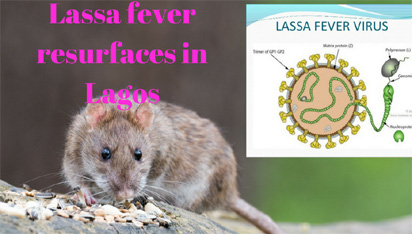
How to Locate and Dispose a Dead Rat
March 2, 2023Diseases Spread by Rats

Rats are experts on trespassing, destroying your home and stealing your food. But they don’t just invade your food, destroy your important documents and leave their droppings, the worst thing about them is that they spread viruses and bacteria that causes several types of diseases to humans. This substances are spread through their droppings, urine, and parasite. There has been recent cases of Lassa fever in Nigeria and it happens to be one of the diseases caused by rats. Rats are a very serious risk to public health and thrive in our sewers, gutters, overflowing bins and litter-strewn public spaces.
Rat infestations and human contact with rats can cause health problems, problems with contamination, and damage to property. That is why it is necessary that when you see rat traces in form of droppings, scratches or bad order watch it very well because they should be treated as a health hazard. Better still eradicate rats around your home completely.
List of diseases that rats carry:
Globally, rats are known to spread over 35 diseases to humans. Diseases transmitted by rats have been divided into two categories: diseases transmitted directly from exposure to rat-infected feces, urine or bites and diseases indirectly transmitted to people by an intermediate arthropod vector such as fleas, ticks or mites. Rats and mice are known to spread diseases directly or indirectly. Direct transmission occurs when humans accidentally touch infected urine, droppings, or rodents.
Diseases Directly Transmitted by Rats
-
Hantavirus Pulmonary Syndrome: a severe respiratory disease causing flu-like symptoms, dizziness, and stomach problems at first, then extreme shortness of breath. Hantavirus Pulmonary Syndrome (HPS) is a severe illness caused from exposure to the droppings or urine of deer mice that carry the virus.
-
Leptospirosis: This is a bacterial disease that can be transmitted by coming into contact with infected water by swimming, wading or kayaking or by contaminated drinking water. Individuals may be at increased risk of Leptospirosis infections if they work outdoors or with animals. In summary, a bacterial disease causing flu-like symptoms, plus jaundice and red eyes
-
Rat-bite Fever: Rat bite fever is a bacterial disease. The bacteria are carried by rats and are part of the normal flora of their mouth and nose. People can get infected through bites or scratches by rats. Up to 10% of rat bites may result in rat bite fever. Other animals such as mice, gerbils, squirrels, cats and dogs can also get infected and may or may not get sick with rat bite fever, and can spread it.
-
Salmonellosis: Salmonellosis is a bacterial infection of the intestines caused by a group of bacteria called Salmonella. The bacteria are shed in the stool of infected animals and humans. Infection can happen when a person eats food or drinks water or milk that has been contaminated with Salmonella bacteria. Infection with Salmonella can cause serious disease, especially in children younger than 5 years of age, the elderly, and persons with weakened immune systems.
List of Diseases Indirectly Transmitted by Rats
Indirect transmission happens when a rat’s parasites (like ticks and mosquitoes) also bite and infect humans; the diseases they can transmit include babesiosis, Lyme disease, and West Nile. Rats do not transmit rabies, Corrigan notes.
-
Plague: This disease is carried by rats and transmitted by fleas in the process of taking a blood meal. Domestic rats are the most common reservoir of plague.
-
Colorado Tick Fever: This is a viral disease that is transmitted by the bite of a tick that has taken a blood meal from a bushy-tailed woodrat.
-
Cutaneous Leishmaniasis: This disease is a parasite that is transmitted to a person by the bite of an infected sand fly that has fed on a wild woodrat.
How do rats spread disease?
Rats pick up viruses in the same way human beings do: with their fingers and mouths. “They’re hanging out in alleys, by garbage cans, and in sewers,” Corrigan explains. “All those germs get picked up on their feet, and they eat them.” (Luckily for us, we can wash our hands.)
From the moment they enter a home, rats are almost “constantly urinating and defecating,” Corrigan says, leaving viruses wherever they go—including on your surfaces, around your basement, and in your pantry. Unsuspecting people then touch, inhale, and sometimes consume that urine and feces, allowing those germs into their bodies.
What Are the Preventive Measures to Control Diseases Caused by Rats?
There are 3 simple preventive measures to control the diseases caused by rats, including-
- Sealing all entry holes, including cracks, crevices and holes to prevent rats and mice from entering.
- Trapping is a permanent solution to keep diseases caused by rats at bay.
- Cleaning and disinfection of the rodent-infested area are essential to keep the diseases caused by rats at bay. Individuals must be cautious while cleaning such areas and wear masks and gloves to avoid contamination.
Tips for effective rat control
Given the speed with which rats breed, control efforts should focus on careful monitoring for the presence of rodents in or near your house. This allows you to quickly and efficiently remove them before they have a chance to begin breeding, at which point the infestation will become much more complicated to handle.
Monitoring
First, learn to identify the telltale signs of rats. These may be found inside your house or outside, especially around garbage cans, drains, and shrubbery.
Preventative control
Rats can only reproduce continuously if they have a steady supply of food and water. Making your home less appealing to rodents can help to keep them out and stop them from breeding!
Active control
If you see any sign of rats in or around your house, you need to act immediately to remove them before they start to multiply. This can be achieved by rat traps and rat poising in rat bait stations
Note that the most effective rat control is by a rat control experts



